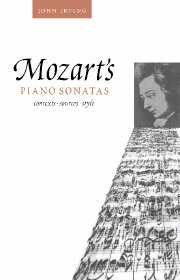1 - The solo sonata in context
Published online by Cambridge University Press: 15 December 2009
Summary
What kind of a composition was the solo sonata inherited by the young Mozart? In what situations would such a sonata have been played? For what sort of audience was it intended? In what ways might the cultural identity of that audience have influenced its expectations of a solo sonata and, consequently; the composer's work? Answers to preliminary questions such as these are required in order to arrive at a proper contextual appreciation of the solo piano sonata of the early classical period, and specifically, Mozart's contribution to this important genre.
J. A. P. Schultz, writing in 1775 put the matter thus:
in no form of instrumental music is there a better opportunity than in the sonata to depict feelings without words… [except for symphonies, concertos and dances] there remains only the form of the sonata, which assumes all characters and every expression.
This was in sharp contrast to the views held by the preceding generation of aestheticians, most notably by the rhetorician, Johann Christoph Gottsched, trenchantly expressed in his translation of Batteux's Les Beaux Arts Réduits à un même Principe:
Music by itself is soulless and unintelligible when it does not cling to words, which must speak for it, so that one knows what it means … [a sonata is] a labyrinth of tones, which sound neither happy nor sad, neither touching nor moving.
Such an observation stems from the philosophical principle that music is an imitation (mimesis) of nature, intended to impart a kind of secondary effect (such as ‘moral improvement’) in the perceiver, and that instrumental music is powerless to achieve this task without a clear succession of objects provided by a text.
- Type
- Chapter
- Information
- Mozart's Piano SonatasContexts, Sources, Style, pp. 3 - 15Publisher: Cambridge University PressPrint publication year: 1997

